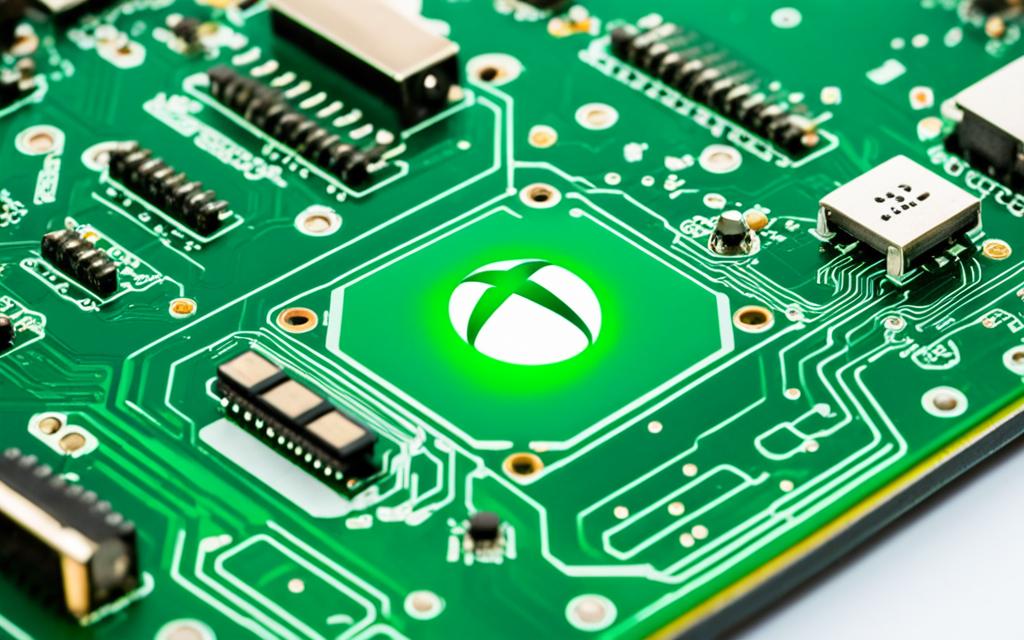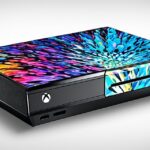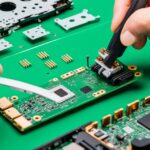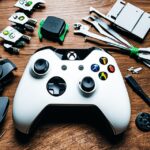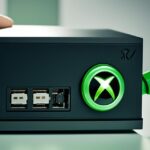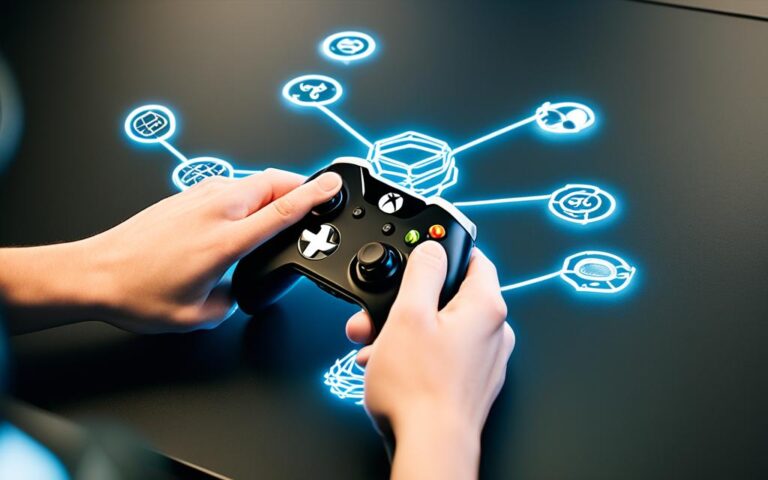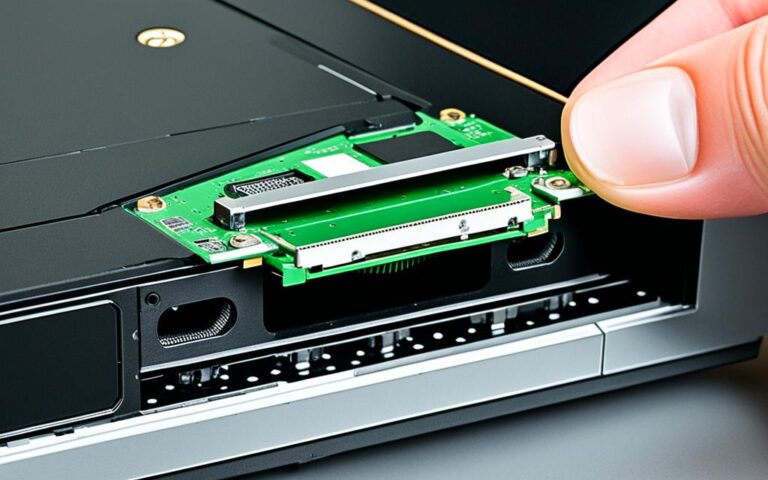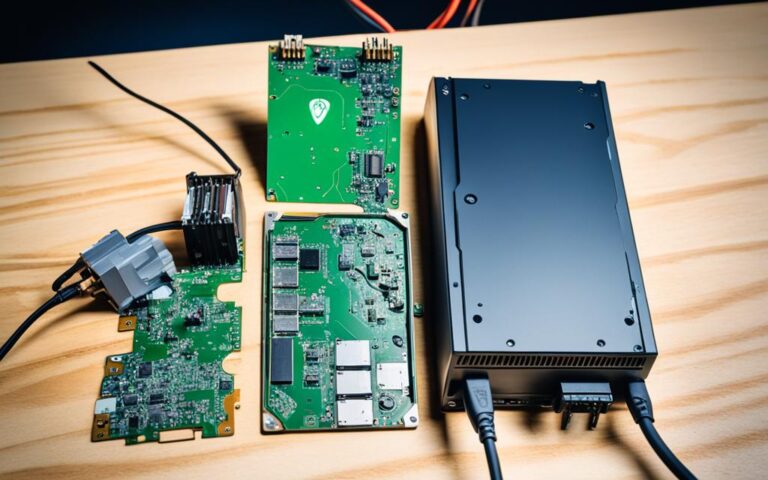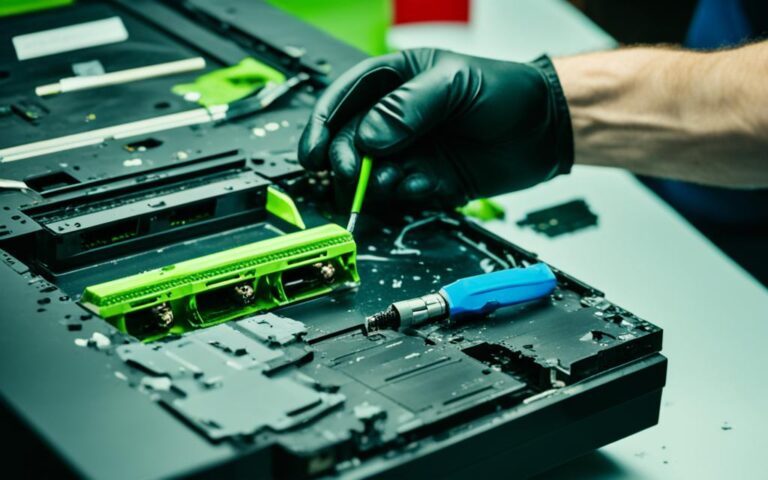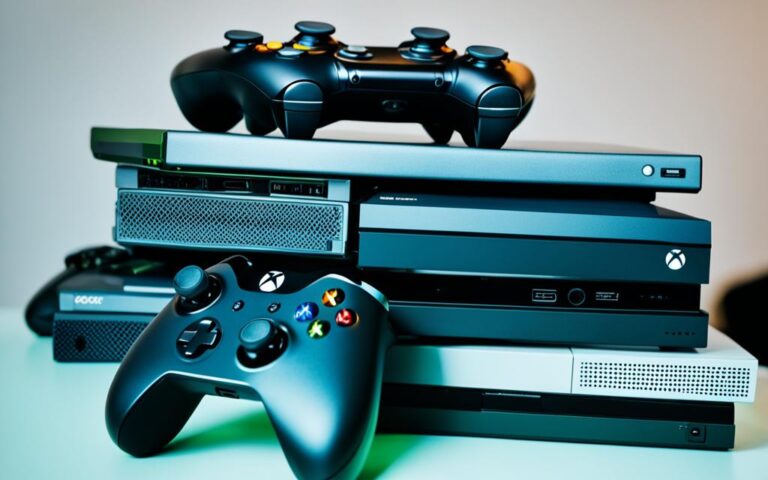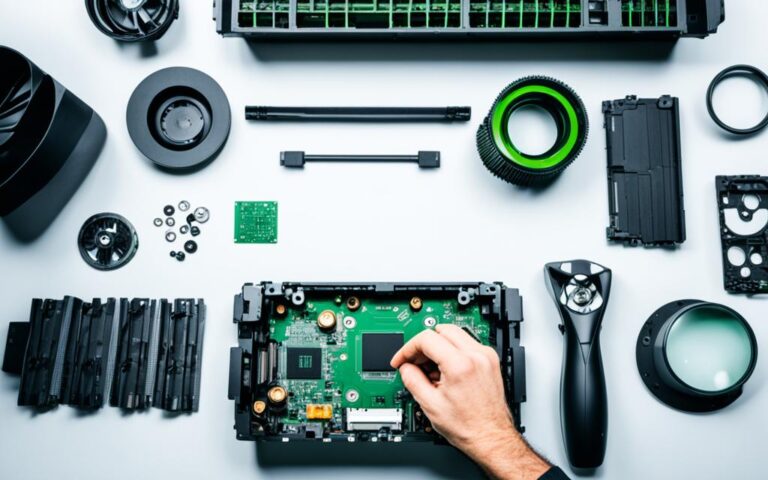Xbox Dashboard Glitches: Repair Tips
Welcome to our guide on how to repair Xbox Dashboard glitches. If you’ve been experiencing issues such as unresponsive screens, applications not loading, visual glitches, or missing custom pins, you’ve come to the right place. In this article, we will provide you with valuable repair tips to help you troubleshoot these common problems.
One of the first steps in troubleshooting Xbox Dashboard glitches is to refresh the Xbox Home screen. By refreshing the Home screen, you can often resolve issues and ensure that your console is functioning optimally. Refreshing the Home screen can also update customization options and layout changes. To refresh the Xbox Home screen, press the Xbox button to open the guide menu, navigate to the Home screen options, and select “Refresh.” For original Xbox One consoles, the process may vary slightly.
In the next sections, we will explore common Xbox Dashboard errors, provide step-by-step instructions on how to refresh your Xbox Home screen, and offer troubleshooting tips for booting issues. We will also discuss common Xbox One problems and solutions, as well as how to get in touch with Microsoft for support.
Stay tuned for valuable insights and expert advice to help you resolve Xbox Dashboard glitches and ensure a seamless gaming experience.
Common Xbox Dashboard Errors
When it comes to the Xbox Dashboard, there are a few common errors that users may encounter. These errors can disrupt the normal functioning of the dashboard and hinder the overall gaming experience. It’s crucial to recognize these errors and understand how to address them to ensure smooth gameplay.
Some of the most common Xbox Dashboard errors include:
- Applications not loading or appearing on the Home screen
- Soft-locked or unresponsive Home screen
- On-screen visual glitches or errors
- Custom pins not appearing as they should
These errors can be frustrating, but they can often be resolved by refreshing the Home screen. Refreshing the Home screen reloads all the components and can help troubleshoot these issues. By recognizing these errors and understanding the need for a refresh, users can effectively address Xbox Dashboard glitches.
To refresh the Xbox Home screen, users can follow these steps:
- Press the Xbox button to open the guide menu.
- Navigate to the Home screen options.
- Select “Refresh.”
For original Xbox One consoles, the process may vary slightly. Consult the Xbox support documentation for specific instructions based on the console model.
By refreshing the Xbox Home screen, users can often resolve these common errors and ensure a seamless gaming experience.
Troubleshooting Common Xbox Dashboard Errors
| Error Type | Possible Causes | Solution |
|---|---|---|
| Applications not loading or appearing on the Home screen | – Network connectivity issues – Outdated applications – Corrupted game files |
– Check network connection – Update applications – Reinstall game files |
| Soft-locked or unresponsive Home screen | – System overload – Memory issues – Operating system glitches |
– Perform a hard reset – Clear temporary files – Update console software |
| On-screen visual glitches or errors | – Graphics driver issues – Compatibility problems – Display settings misconfiguration |
– Update graphics drivers – Ensure game compatibility – Adjust display settings |
| Custom pins not appearing as they should | – Pinning errors – Software conflicts – Dashboard customization issues |
– Unpin and re-pin items – Check for conflicting software – Customize dashboard layout |
How to Refresh Your Xbox Home Screen
To resolve common issues affecting the functionality of your Xbox Home screen, refreshing it is often a simple but effective solution. By following these steps, you can refresh your Xbox Home screen and restore its optimal performance.
-
Press the Xbox button to open the guide menu.
-
Navigate to the Home screen options.
-
Select “Refresh” to reload the entire Home screen.
This process will address common problems such as applications not loading, unresponsive screens, visual glitches, and missing custom pins. Additionally, refreshing the Home screen periodically ensures that customization options and layout changes are updated.
It’s important to note that for original Xbox One consoles or consoles requiring a full update, the process may differ slightly. Simply press and hold the Left Trigger and Right Trigger on the Home screen, then press the Y Button to refresh the screen.
Why Refreshing Your Xbox Home Screen Matters
Refreshing your Xbox Home screen can help in several ways:
-
Resolve common issues affecting functionality.
-
Update customization options and layout changes.
-
Improve overall performance and responsiveness.
By regularly refreshing your Xbox Home screen, you can ensure a smooth and enjoyable gaming experience.
Refresh Xbox Home Screen – Step by Step Guide
“Refreshing the Xbox Home screen is a crucial troubleshooting step for common issues like unresponsive screens and missing custom pins. The process is straightforward, and it can quickly restore the functionality of your console.”
This handy step-by-step guide will help you refresh your Xbox Home screen:
| Steps | Description |
|---|---|
| 1 | Press the Xbox button to open the guide menu. |
| 2 | Navigate to the Home screen options. |
| 3 | Select “Refresh” to reload the entire Home screen. |
Following these steps will help you address common Xbox Home screen issues and ensure smooth gameplay.
Troubleshooting Xbox Booting Issues
If your Xbox console is not booting into the dashboard, there could be various causes. One possible solution is to remove and reinsert the hard drive. If the console recognizes the hard drive but still doesn’t boot, it could be a problem with the dashboard or a specific game. Checking for errors or trying a different game disc may help troubleshoot the issue. In some cases, modchips or a replacement console may be necessary.
If you’re experiencing difficulties with your Xbox console not booting properly, try the following troubleshooting steps:
- Remove and reinsert the hard drive: Sometimes a loose connection can prevent the console from booting. Turn off your Xbox, disconnect the hard drive, and then securely reattach it. Power on the console again to see if the issue is resolved.
- Check for errors: When the console fails to boot, it’s worth checking for any error messages or codes displayed on the screen. These messages can provide valuable insights into the specific issue that’s preventing the dashboard from loading. Search for the error code online to find troubleshooting steps specific to your situation.
- Try a different game disc: Faulty game discs can sometimes interfere with the booting process. Insert a different game disc into your Xbox console and see if it boots successfully. If it does, the issue may be with the specific game you were trying to play.
- Consider modchips or replacement console: If none of the above steps resolve the booting issue, it may be necessary to explore more advanced solutions. Modchips, which are hardware modifications to the console, can sometimes help bypass booting problems. Alternatively, if you have access to a spare console, you may consider using it as a replacement.
By following these troubleshooting steps, you can address common booting issues with your Xbox console and get it back up and running smoothly. If you continue to experience difficulties, it’s recommended to reach out to Xbox support for further assistance.
Common Xbox One Problems and Solutions
When it comes to the Xbox One, users may encounter a range of issues that can hinder their gaming experience. In this section, we will explore some of the most common problems that Xbox One owners face and provide practical solutions to resolve them. Whether you are stuck on the splash screen, experiencing disc drive issues, or encountering network connection problems, we have got you covered.
Splash Screen Stuck during Bootup
One frustrating problem that Xbox One users may encounter is being stuck on the splash screen during bootup. This can prevent you from accessing your games and features. To resolve this issue, try performing a hard reset on your console. Simply hold down the power button for 10 seconds until the console turns off. Wait for a few seconds, then turn it back on.
Grinding Sounds from the Disc Drive
If you notice grinding sounds coming from your Xbox One’s disc drive, it could be a sign of a mechanical issue. To address this problem, try the following solutions:
- Clean the disc: Ensure that the disc you are using is clean and free from scratches or debris. Wipe it gently with a soft cloth.
- Check for debris: Inspect the disc drive for any foreign objects or debris that may be causing the grinding noise. If found, remove the obstruction carefully.
- Contact Microsoft support: If the problem persists, it may be necessary to contact Microsoft support for further assistance or to arrange a repair.
Console Not Updating
Keeping your Xbox One updated is crucial for optimal performance. If your console is not updating properly, try the following steps:
- Check your internet connection: Ensure that your Xbox One is connected to the internet. A stable and reliable connection is necessary for system updates.
- Restart your console: Sometimes a simple restart can resolve update issues. Power off the console, unplug it from the power outlet, wait for 10 seconds, then plug it back in and turn it on.
- Manually update the console: If the automatic update fails, you can try manually updating your Xbox One. Visit the official Xbox support website for detailed instructions on how to perform a manual update.
Power Issues
If you are experiencing power issues with your Xbox One, such as it not turning on or randomly turning off, try the following solutions:
“Make sure that the power cable is securely connected to the console and the power outlet. If you are using a power strip or extension cord, try plugging the console directly into a wall outlet. Additionally, check that the power brick’s LED light is illuminated, indicating that it is receiving power.”
If the power issues persist, contact Microsoft support for further troubleshooting or to explore repair options.
Display Resolution Problems
Are you experiencing display resolution problems with your Xbox One? Follow these steps to address the issue:
- Check your TV settings: Ensure that your TV is set to the correct resolution and display settings that are compatible with the Xbox One.
- Adjust the Xbox One video output settings: Access the “Display & sound” settings on your console and select “Video output.” From there, you can adjust the resolution and other display settings to match your TV.
- Try a different HDMI cable: Faulty or incompatible HDMI cables can cause display resolution problems. Consider trying a different cable to see if that resolves the issue.
Audio Issues
If you are experiencing audio problems on your Xbox One, such as distorted sound or no audio at all, try the following solutions:
- Check audio settings: Ensure that the audio settings on your console are properly configured. Check that the correct audio output is selected and that the volume is turned up.
- Try a different audio source: Test your audio output by connecting headphones or external speakers to your Xbox One. If the audio works fine through an alternative source, then the issue may be with your TV or audio setup.
- Restart your console: Sometimes a simple restart can resolve audio problems. Power off the console, unplug it from the power outlet, wait for 10 seconds, then plug it back in and turn it on.
Game Installation Difficulties
Encountering difficulties while installing games on your Xbox One can be frustrating. Follow these steps to troubleshoot game installation problems:
“Ensure that your console has enough storage space available for the game you are trying to install. If your storage is full, consider deleting or transferring unnecessary files. If the installation error persists, try installing a different game to determine if the problem is specific to the game disc or download.”
Controller Syncing Problems
If your Xbox One controller is not syncing with your console, try the following solutions:
- Restart your console and controller: Power off the console, unplug it from the power outlet, wait for 10 seconds, then plug it back in and turn it on. Similarly, remove the batteries from your controller, wait for a few seconds, then reinsert them.
- Ensure controller compatibility: Some Xbox One controllers are not compatible with certain console models. Make sure that your controller is compatible with your console.
- Try a USB cable connection: Connect your controller to the console using a USB cable. This can help establish a connection and troubleshoot syncing issues.
Disc Reading Issues
If your Xbox One is having trouble reading discs, follow these steps to address the issue:
- Clean the disc: Wipe the disc gently with a soft cloth to remove any smudges, dirt, or fingerprints that may be affecting the reading process.
- Restart your console: Power off the console, unplug it from the power outlet, wait for 10 seconds, then plug it back in and turn it on. Retry inserting the disc.
- Test with a different disc: Try inserting a different game or movie disc to determine if the issue is specific to a particular disc. If other discs work fine, the problem may be with the original disc.
Game Freezing or Crashing
Dealing with game freezing or crashing can be frustrating and disruptive. Follow these steps to troubleshoot such issues:
“Check for game updates: Ensure that your game is up to date with the latest patches and updates. Developers often release updates to fix known issues or bugs that can cause freezing or crashing.”
If the problem persists, try reinstalling the game or contacting the game’s developer for further assistance.
Network Connection Problems
Experiencing network connection problems on your Xbox One can hinder multiplayer gaming and access to online features. Follow these steps to resolve network connection issues:
- Check your internet connection: Ensure that your Xbox One is connected to a stable internet connection. Consider restarting your router or modem to refresh the connection.
- Test network connection on other devices: If possible, check if other devices on your network are experiencing similar connection issues. This can help determine if the problem is with your Xbox One or your internet service provider.
- Adjust DNS settings: Manually configuring the DNS settings on your console can sometimes resolve network connection problems. Consult your internet service provider for the appropriate DNS settings.
Kinect Pairing Troubles
If you are having trouble pairing your Kinect sensor with your Xbox One, try the following solutions:
- Check the Kinect cables: Ensure that all cables connecting the Kinect sensor to the console are securely plugged in. Try disconnecting and reconnecting them to ensure a proper connection.
- Update the Kinect software: Ensure that your Kinect sensor has the latest software updates installed. Updates can introduce improvements and resolve compatibility issues.
- Restart your console: Power off the console, unplug it from the power outlet, wait for 10 seconds, then plug it back in and turn it on. Retry pairing the Kinect sensor.
By following these solutions, you can address many of the common problems that Xbox One owners encounter. However, if you are unable to resolve the issue on your own, don’t hesitate to reach out to Microsoft support for further assistance. They are dedicated to helping you get back to your gaming adventures.
Getting in Touch with Microsoft
To address any Microsoft support needs, including Xbox Dashboard repair, contacting Microsoft directly is essential. There are several options available to connect with their support team and receive the assistance you require.
1. Live Chat
Engage in a live chat session with a Microsoft support representative to discuss your Xbox dashboard repair concerns. This interactive platform allows for real-time communication, ensuring efficient troubleshooting and prompt resolution.
2. Forums
Participate in community forums where Xbox users can share experiences, seek advice, and receive assistance. Engaging in these discussions can provide valuable insights and potential solutions to various Xbox Dashboard issues.
3. Self-Help Resources
Visit the Microsoft website to access a wide range of self-help resources. These include step-by-step guides, troubleshooting articles, and frequently asked questions (FAQs) that address common Xbox Dashboard repair queries and provide detailed instructions for resolving issues.
4. Phone Support
If you prefer direct communication, you can reach out to Microsoft’s dedicated phone support helpline. Trained professionals will guide you through the necessary troubleshooting steps, offer expert advice, and provide tailored solutions for your Xbox Dashboard repair needs.
5. Request a Call
If you would like Microsoft to contact you directly, you can submit a call request on their website. Provide your contact information and a brief description of the issue you are facing, and a Microsoft representative will be in touch to assist you.
6. Twitter Support
Utilize the power of social media by reaching out to Microsoft’s official Xbox Support handle on Twitter. Tweet your concerns to @XboxSupport, and their team will respond with guidance, resources, or instructions to address your Xbox Dashboard repair queries.
For an expedited resolution and to keep track of warranty repairs, it is recommended to register your Xbox console on Microsoft’s website. This process also enables you to check the status of your warranty and access additional repair services if required.
By utilizing these diverse contact options, you can receive the necessary assistance from Microsoft’s support team and ensure a smooth Xbox Dashboard repair process.
Image: Microsoft Support
Conclusion
In conclusion, troubleshooting Xbox Dashboard glitches and errors can be done by refreshing the Home screen, addressing common problems with booting, and seeking support from Microsoft for more complex issues. Regular maintenance and staying updated with the latest console updates can help prevent and resolve various Xbox Dashboard problems.
Refreshing the Home screen is a simple and effective way to resolve common issues such as applications not loading, unresponsive screens, visual glitches, and missing custom pins. By periodically refreshing the Home screen, users can also update customization options and layout changes.
For more complex issues, it is recommended to seek support from Microsoft. They offer various channels for assistance, including live chat, forums, self-help resources on their website, phone support, and requesting a call. Registering your Xbox console on Microsoft’s website can also help expedite warranty repairs and check the status of your warranty.
Regular maintenance and staying up to date with the latest console updates are essential for preventing and resolving Xbox Dashboard problems. This includes performing regular system updates, checking for errors, and keeping hardware connections in check. By following these guidelines, Xbox users can ensure smoother gameplay and a better overall gaming experience.
